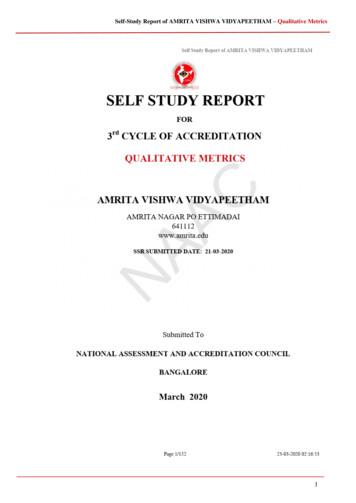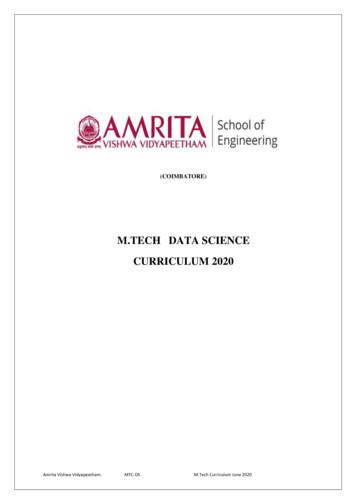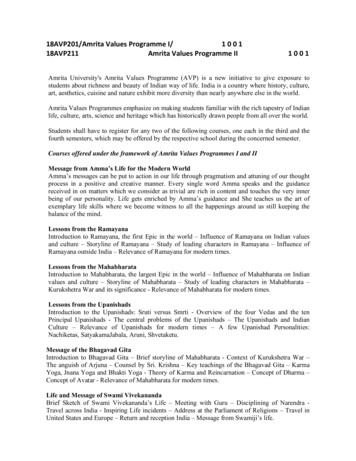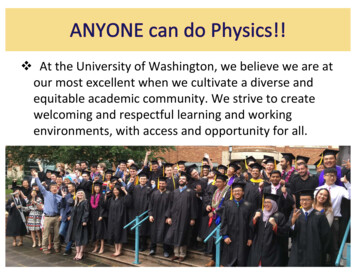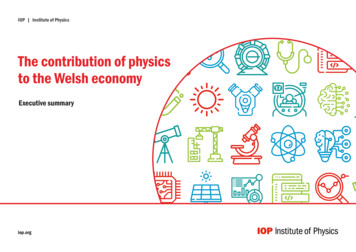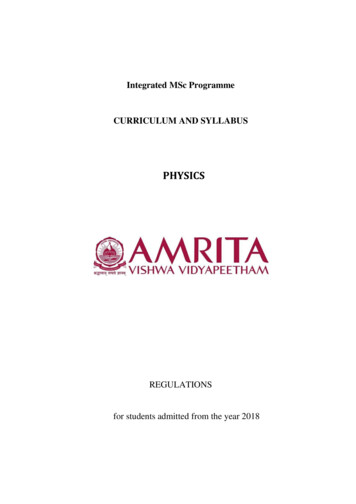
Transcription
Integrated MSc ProgrammeCURRICULUM AND SYLLABUSPHYSICSREGULATIONSfor students admitted from the year 2018
Vision of the InstituteTo be a global leader in the delivery of engineering education, transforming individuals to becomecreative, innovative, and socially responsible contributors in their professions.Mission of the Institute:1. To provide best-in-class infrastructure and resources to achieve excellence in technicaleducation,2. To promote knowledge development in thematic research areas that have a positive impact on society,both nationally and globally,3. To design and maintain the highest quality education through active engagement with allstakeholders –students, faculty, industry, alumni and reputed academic institutions,4. To contribute to the quality enhancement of the local and global education ecosystem,5. To promote a culture of collaboration that allows creativity, innovation, and entrepreneurship toflourish, and6. To practice and promote high standards of professional ethics, transparency, andaccountability
PROGRAM OUTCOMES (PO)Students of all Integrated/PG degree Programmes at the time of graduation will be able toPO1. Science knowledge: Knowledge of basic science fundamentalsPO2. Problem analysis: Develop analytical skills to identify, formulate, analyze complexmechanisms using first principles basic sciences.PO3. Development of solutions: Design solutions for complex chemical process problemsand evolve procedures that meet the specified needs with appropriate consideration for thepublic health and safety and environmental considerations.PO4. Critical review of solutions: Use of research-based knowledge and research methodsincluding design of experiments, analysis and interpretation of data, and synthesis of theinformation to provide valid conclusions.PO5. Modern analytical tool usage: Select, and apply appropriate techniques, resources,and modern analytical toolsPO6. The scientist and society: Apply reasoning through the contextual knowledge to assesssocietal, health, safety, legal and cultural issues and the consequent responsibilities relevantto the professional chemical practice.PO7. Environment and sustainability: Understand the impact of the chemical processes insocietal and environmental contexts, and demonstrate the knowledge of, and need forsustainable development.PO8. Ethics: Apply ethical principles and commit to professional ethics and responsibilitiesand norms of the chemistry practice.PO9. Individual and team work: Function effectively as an individual, and as a member orleader in diverse teams, and in multidisciplinary settings.PO10. Communication: Communicate effectively on complex scientific activities with thescience community and with society at large, such as, being able to comprehend and writeeffective reports and design documentation, make effective presentations, and give andreceive clear instructions.PO11. Project management and finance: Demonstrate knowledge and understanding of thescientific and management principles and apply these to one‘s own work, as a member andleader in a team, to manage projects and in multidisciplinary environmentsPO12. Life-long learning: Recognize the need for, and have the preparation and ability toengage in independent and life-long learning in the broadest context of technological change
PROGRAM SPECIFIC OUTCOMES (PSO)PSO1: Students will demonstrate proficiency in mathematics and the mathematicalconcepts needed for a proper understanding of physics.PSO2: Students will demonstrate knowledge of classical mechanics, electromagnetism,quantum mechanics, and thermal and statistical physics, and be able to apply thisknowledge to analyze a variety of physical phenomena and related subjects.PSO3: Students will acquire experimental skills which enable them to take precisemeasurements in labs and analyze the measurements to draw valid conclusions. Inaddition, students will exhibit skills in solving problems numerically using computerprogramming, plotting tools, and related software.PSO4: Students will showenhanced oral and written scientific communication skills andbe able to think critically and work independently as well as in a team and play beneficialrole in the society as a person with better scientific outlook.
Integrated MSc ProgrammePHYSICSCURRICULUM2018 admission onwards
SEMESTER ICode 18CSA18018CUL101Course TitleCommunicative EnglishLanguage IChemistry IProblem Solving and Computer ProgrammingTrigonometry and Differential EquationsMechanics and Properties of MatterChemistry Lab IProblem Solving and Computer Programming LabCultural Education EMESTER IICode 18PHY18518PHY18318CUL111Course TitleProfessional CommunicationLanguage IIChemistry IIAdvanced Computer Programming Introduction to PythonMatrices and Vector CalculusBasics of Electricity and MagnetismChemistry Lab II - InstrumentalAdvanced Computer Programming / PythonLabPhysics Lab I - Mechanics and Properties of MatterCultural Education 1223SEMESTER IIICode 18AVP201TOTALCourse TitleBasic Experimental Techniques in PhysicsOptics and Wave MotionElective AAnalog ElectronicsIntroduction to Mathematical PhysicsPhysics Lab II –Heat, Electricity and MagnetismLife Skills IAmrita Value Programme ILTP310310300310310002102100Cr4434412123
SEMESTER IVCode 18AVP211Course TitleEnvironmental Science and SustainabilityDigital ElectronicsElective BIntroduction to computational PhysicsPhysics Lab III - OpticsModern PhysicsLife Skills IIAmrita Value Programme STER VCode Course TitleThermal PhysicsElectrodynamicsSolid State PhysicsFree/Open Elective* /Living Lab@Elective CPhysics Lab IV – Modern PhysicsLife Skills R VICode rse TitleAtomic and Molecular PhysicsIntermediate MechanicsModern OpticsElective DPhysics Lab V – ElectronicsLTP310310310300002Project (for Exit-option students)TOTAL (for Exit-option students)Cr4443116622TOTALFor Exit option128134
SEMESTER VIICode 18PHY591Course TitleClassical MechanicsQuantum Mechanics IMathematical Physics IComputational PhysicsAdvanced Physics LabSimulation LabMini ESTER VIIICode Course TitleQuantum Mechanics IIMathematical Physics IIStatistical MechanicsAdvanced ElectrodynamicsExperimental TechniquesAdvanced Electronics LabLTP310310310310310006TOTALCr44444222SEMESTER IXCode No18PHY60118PHY60218PHY60318PHY681Course TitleAtomic, Molecular and Optical PhysicsCondensed Matter PhysicsNuclear and Particle PhysicsElective IElective IISpectroscopy LabLTP310310310300300006TOTALCr44433220SEMESTER XCode No18PHY69618PHY697TOTALCourse TitleDissertationViva voceTOTAL for 5 YR Int. MScElectives – A, B, C, DLTPCr18220210
Course 18PHY34718CHY33118CHY35318CHY34818CHY631Course TitleMedical PhysicsIntroduction to Nanophysics And ApplicationsBiophysicsAstronomyComputational Methods for PhysicistsConcepts of Nanophysics and NanotechnologyIntroduction to PhotonicsNonlinear OpticsOptical EngineeringPhysics of Semiconductor DevicesPrinciples of Lasers and Laser ApplicationsLaser TheoryLaser ApplicationsBatteries and Fuel CellsForensic scienceElectrochemistryApplied 00300300300300300300Cr33333333333333333ELECTIVES – I, IICourse Y656Course TitleAstrophysicsBiophotonicsEarth‘s AtmosphereEarth‘s Structure and EvolutionFibre-optic Sensors and ApplicationsFibre Optics and TechnologyNanophotonicsNonlinear DynamicsNuclear PhysicsOptoelectronic DevicesPhysics of Cold Atoms and IonsQuantum ElectrodynamicsQuantum OpticsThin Film TechnologyFundamentals of Plasma PhysicsSpace PhysicsUltrafast lasers and ApplicationsEnergy and Environment in the 21st centuryIntroduction to solar physicsMicro and Nano Magnetism Materials and its ApplicationsX-ray Diffraction and its ApplicationsSolar energy conversionFabrication of Advanced Solar cellAstrophysics and CosmologySpecial Theory of RelativityOpen 33333333333333
Course OEL27418OEL27518OEL276Course TitleAdvertisingBasic StatisticsCitizen JournalismCreative Writing for BeginnersDesktop Support and ServicesDevelopment JournalismDigital PhotographyEmotional IntelligenceEssence of Spiritual LiteratureFilm TheoryFundamentals of Network AdministrationGender StudiesGlimpses of Indian Economy and PolityGraphics and Web-designing ToolsGreen MarketingHealthcare and TechnologyHistory of English LiteratureIndian Writing in EnglishIndustrial Relations and Labour WelfareIntroduction to Ancient Indian Yogic and Vedic WisdomIntroduction to Computer HardwareIntroduction to Event ManagementIntroduction to MediaIntroduction to Right to Information ActIntroduction to TranslationLinguistic AbilitiesLiterary Criticism and TheoryMacro EconomicsManaging FailureMedia ManagementMicro EconomicsMicro Finance, Small Group Management and CooperativesNegotiation and CounsellingNew LiteraturesNon-Profit OrganisationPersonal EffectivenessPerspectives in Astrophysics and CosmologyPrinciples of MarketingPrinciples of Public RelationsScience, Society and CultureStatistical AnalysisTeamwork and CollaborationThe Message of Bhagwad GitaUnderstanding Travel and TourismVideographyVistas of English LiteratureLTP3 0 03 0 03 0 03 0 03 0 03 0 03 0 03 0 03 0 03 0 03 0 03 0 03 0 03 0 03 0 03 0 03 0 03 0 03 0 03 0 03 0 03 0 03 0 03 0 03 0 03 0 03 0 03 0 03 0 03 0 03 0 03 0 03 0 03 0 03 0 03 0 03 0 03 0 03 0 03 0 03 0 03 0 03 0 03 0 03 0 03 0 0Cr3333333333333333333333333333333333333333333333
L28918OEL29018OEL29118OEL29218OEL293Web-Designing TechniquesOrganic FarmingBasic Legal Awareness on Protection of Women and RightsRitual Performances of KeralaDocumenting Social IssuesFabrication of Advanced Solar CellBasic Concepts of X-ray DiffractionIntroduction to FORTRAN and GNUPLOTIntroduction to Porous MaterialsForensic ScienceIntroduction to solar PhysicsRecycling Recovery and Treatment Methods for WastesActing and Dramatic PresentationComputerised AccountingKerala Mural Art and PaintingPaintingReporting Rural 002222033333333333333333LANGUAGESPaper ICourse Code18HIN10118KAN10118MAL10118SAN10118TAM101Course TitleHindi IKannada IMalayalam ISanskrit ITamil ILTP102102102102102Cr22222ESBBBBBCourse TitleHindi IIKannada IIMalayalam IISanskrit IITamil IILTP102102102102102Cr22222ESBBBBBPaper IICourse Code18HIN11118KAN11118MAL11118SAN11118TAM111* Two Open Elective courses are to be taken by each student, one each at the 4th and the 5th semesters, fromthe list of Open electives offered by the School.@Students undertaking and registering for a Live-in-Lab project, can be exempted from registering for an OpenElective course in the fifth semester.Evaluation Pattern
50:50 (Internal: External) (All Theory Courses)AssessmentInternal ExternalPeriodical 1 (P1)15Periodical 2 (P2)15*Continuous Assessment(CA)20End Semester5080:20 (Internal: External) (Lab courses and Lab based Courses having 1 Theory hour)AssessmentInternal External*Continuous Assessment(CA)80End Semester2070:30(Internal: External) (Lab based courses having 2 Theory hours/ Theory andTutorial)Theory- 60 Marks; Lab- 40 MarksAssessmentInternal ExternalPeriodical 110Periodical 210*Continuous Assessment(Theory) (CAT)10Continuous Assessment(Lab) (CAL)40End Semester30
65:35 (Internal: External) (Lab based courses having 3 Theory hours/ Theory andTutorial)Theory- 70 Marks; Lab- 30 MarksAssessmentInternal ExternalPeriodical 110Periodical 210*Continuous Assessment(Theory) (CAT)15Continuous Assessment(Lab) (CAL)30End Semester35*CA – Can be Quizzes, Assignment, Projects, and ReportsLetter GradeGrade PointGrade DescriptionO10.00OutstandingA 9.50ExcellentA9.00Very GoodB 8.00GoodB7.00Above AverageC6.00AverageP5.00PassF0.00FailGrades O to P indicate successful completion of the courseCGPA (C xGr ) CiiiWhereCi Credit for the ith course in any semesterGri Grade point for the ith courseCr. Credits for the CourseGr. Grade Obtained
Integrated MSc ProgrammePHYSICSSYLLABI2018 admission onwards
18ENG101Communicative English2-0-2-3Objectives:To help students obtain an ability to communicate fluently in English; to enable and enhance thestudents skills in reading, writing, listening and speaking; to impart an aesthetic sense and enhancecreativityCourse Contents:Unit IKinds of sentences, usage of preposition, use of adjectives, adverbs for description, Tenses,Determiners- Agreement (Subject – Verb, Pronoun- Antecedent) collocation, Phrasal Verbs,Modifiers, Linkers/ Discourse Markers, Question TagsUnit IIParagraph writing – Cohesion - Development: definition, comparison, classification, contrast, causeand effect - Essay writing: Descriptive and NarrativeUnit IIILetter Writing - Personal (congratulation, invitation, felicitation, gratitude, condolence etc.) Official(Principal / Head of the department/ College authorities, Bank Manager, Editors of newspapers andmagazines)Unit IVReading Comprehension – Skimming and scanning- inference and deduction – Reading differentkinds of material –Speaking: Narration of incidents / stories/ anecdotes- Current News AwarenessUnit VProse: John Halt‘s ‗Three Kinds of Discipline‟ [Detailed]Max Beerbohm‘s ‗The Golden Drugget‘ [Detailed]Poems: Ogden Nash- „This is Going to Hurt Just a Little Bit‘ [Detailed]Robert Kroetsch– „I am Getting Old Now‘, Langston Hughes- ‗I, Too‘ [Detailed]Wole Soyinka- ‗Telephone Conversation‘ [Non-Detailed]Kamala Das- ‗The Dance of the Eunuchs‘ [Non-Detailed]Short Stories: Edgar Allan Poe‘s ‗The Black Cat‟, Ruskin Bond‘s ‗The Time Stops at Shamili‟ [NonDetailed]Outcomes:CO1: Demonstrate competency in all the four linguistic skills, viz. listening, speaking, reading andwritingCO2: Apply different styles of communication in professional contextCO3: Participate in different planned & extempore communicative activitiesCO4: Interpret and discuss facts and information in a given contextCO5: Develop an appreciation for human valuesCORE READING:
1. Ruskin Bond, Time Stops at Shamli and Other Stories, Penguin Books India Pvt Ltd, 19892. Syamala, V. Speak English in Four Easy Steps, Improve English Foundation Trivandrum:20063. Beerbohm, Max, The Prince of Minor Writers: The Selected Essays of Max Beerbohm (NYRBClassics), Phillip Lopate (Introduction, Editor), The New York Review of Book Publishers.4. Edger Allan Poe. The Selected Works of Edger Allan Poe. A Running Press, 2014.5. Online sourcesReferences:1.2.3.4.Ruskin Bond, Time Stops at Shamli and Other Stories, Penguin Books India Pvt Ltd, 1989Martinet, Thomson, A Practical English Grammar, IV Ed. OUP, 1986.Murphy, Raymond, Murphy‟s English Grammar, CUP, 2004Online Sources18CHY103CHEMISTRY I3003Unit 1 Chemical BondingReview of orbital concept and electronic configuration, electrovalency and ionicbond formation, ioniccompounds and their properties, lattice energy, solvationenthalpy and solubility of ionic compounds,covalent bond, covalency, orbital theoryof covalency - sigma and pi bonds - formation of covalentcompounds and theirproperties Hybridization and geometry of covalent molecules - VSEPR theory polar and non-polar covalent bonds, polarization of covalent bond – polarizingpower, polarisability ofions and Fajan‘s rule, dipole moment, percentage ioniccharacter from dipole moment, dipole momentand structure of molecules, coordinatecovalent compounds and their characteristics, molecular orbitaltheory forH2, N2, O2 and CO, metallic bond - free electron, valence bond and band theories, weakchemical bonds – inter and intra molecular hydrogen bond - van der Waalsforces.Unit 2 Thermodynamic ParametersStoichiometry - mole concept, significance of balanced chemical equation – simplecalculations Conditions for occurrence of chemical reactions - enthalpy, entropyand free changes – spontaneity –Thermochemistry - heats of reactions -(formation, combustion, neutralization) - specific heats variation of enthalpy changewith temperature - Kirchhoff‘ relation (integrated form) - bond enthalpyand bondorder - Problems based on the above.Unit 3 KineticsReview of molecularity and order of a reaction, rate law expression and rateconstant - first, second,third and zero order reactions, pseudo-first order reactions(pseudo-unimolecular reactions) - complexreactions - equilibrium and steady stateapproximations -mechanism of these reactions - effect oftemperature on reactionrates - Arrhenius equation and its significance, Michaelis Menden kineticsenzymecatalysis.Unit 4 Electrochemistry
Electrolytes - strong and weak, dilution law, Debye-Huckel theory, faraday‘s laws,origin of potential,single electrode potential, electrochemical series, electrochemicalcells, Nernst equation and itsapplication, reference electrodes - SHE, Ag/AgCl,Calomel.Unit 5 PhotochemistryPhotochemistry, laws of photochemistry - Stark-Eistein law, Beer-Lamberts law,quantum efficiencydetermination, photochemical processes - Jablonsky diagram,internal conversion, rization.Course Outcomes:The student at the end of the course willCO 1CO 2CO 3Understand the fundamental concepts of chemistry to predict the structure and properties ofengineering materialsDevelop analytical skills to evaluate the cause, feasibility and course of chemical reactionsDesign and apply the idea of cutting edge area of chemistry to solve basic science relatedproblemsCO- PO PO8-PO9-PO10-PO11-PO12-REFERENCE BOOKS:1. Principles of Physical Chemistry, B.R. Puri, L.R. Sharma & M.S. Pathania, VishalPublications, 46th, 2013.2. Principles of Inorganic Chemistry, B R. Puri, L.R. Sharma, Vishal Publications, 200818CSA100PROBLEM SOLVING AND COMPUTER PROGRAMMING300 3Introduction to problem solving: algorithm development and flowchart. Introduction to Computerterminologies and computer languages. C Fundamentals: structure of C program: directives,functions, statements, printing strings, comments; compilation and execution, Programming errorsand debugging. Variables and assignment, reading input; data types, constants, identifiers, keywords,operators - arithmetic, logical, relational, assignment; expressions - precedence and associativity, typecast-implicit and explicit; selection statements:- if, if else, nested if, if else ladder, switch. Case.Iterative structures: entry controlled and exit controlled loop, exiting from a loop: break, continue,goto; nested loops. Functions: library functions, user defined functions: defining and callingfunctions, function declaration, passing arguments to a function, returning values from function.
Storage classes - auto, extern, static, register variables, scope of a variable. Recursion. Numbersystems: binary, octal and hexadecimal. Bitwise operators and enumeration.Arrays: one dimensional numeric arrays, initialization, accessing and usage, two dimensional numericarrays, initialization, accessing and usage. Introduction to multidimensional arrays. Strings: literal,variables: initialization, reading, writing and accessing. String handling functions. Array of strings.Passing arrays and strings to functions.Course Outcomes:COCO1CO2CO3CO4CO5DescriptionUnderstand the structured programming constructs: Data types, Control, selection,recursion thereby to understand a given program.Understand and analyze a given program by tracing, identify coding errors and debug them.Apply structured programming constructs and modularity appropriately for given problemScenarios.Develop Computer programs that implement suitable algorithms for problem scenarios andapplication performance.Understand the efficient way of storing and retrieving data.TEXTBOOK:1. Jeri Hanly and Elliot Koffman, “Problem solving and program design in C”, Fifth Edition,Addison Wesley (Pearson), 2007.REFERENCE:1. Reema Thareja, “Computer Fundamentals and programming in C”, Oxford UniversityPress, 2012.18MAT106TRIGNOMETRY AND DIFFERENTIAL EQUATIONS3104Unit 1Trigonometry: (Mathematics for Degree students, P.K.Mittal) Expansions of sin nθ, cosθ, tan nθ inpowers of Sinθ, Cosθ, Tanθ. Expansion of Sinnθ, Cosnθ, Sinmθ, Cosmθ in terms of Sines andCosines of Multiplies of θ – Power series for Sinθ, Cosθ, Tanθ - Hyperbolic Functions - InverseHyperbolic Functions - Logarithm of complex numbers - Summation of Trigonometric Series Gregory Series - Euler Series.Unit 2Differentiation (Calculus, Thomas) Applications of Derivative: Mean Value theory – Concavity andCurve Sketching – Maxima and Minima.Unit 3Differential Equations of First Order: (Advanced Engineering Mathematics, E.Kreyszig) Formationof Differential Equations. Solutions of Differential Equations (Variable Separable, Homogeneous
Equations and Equations reducible to Homogeneous Form, Linear and Equations reducible to LinearForm, Exact Differential Equations and Equations reducible to Exact form). Differential Equationsnot of the first degree (solvable for ‗p‘, solvable for ‗y‘, solvable for ‗x‘, Clairaut‘s Equation).Applications.Unit 4Differential Equations of Higher Order: (Advanced Engineering Mathematics, E.Kreyszig)Homogeneous Linear Differential Equations with Constant Coefficient and Euler- CauchyDifferential Equations, Basis of Solutions and Wronskian. Non Homogeneous Equations - Method ofUndetermined Coefficients and Method of Variation of Parameters.Unit 5Boundary Value Problems for Second Order Equations: Green's function, Sturm ComparisonTheorems and Oscillations, Eigenvalue Problems. Applications.Outcomes:CO1:Understand the basic trigonometric ratios, hyperbolic and inverse trigonometric and inversehyperbolic functionsCO2: Understand the concept of differentiabilty and its applications to find maxima and minimaand curve sketching using first and second derivativesCO3: Understand the basic concepts of ODE, apply them in modeling and solving first orderequations.CO4: Recall the techniques of solving second order linear homogeneous ODE with constantcoefficients. Understand and modify the above techniques for solving Euler-Cauchyequations. Understand and apply methods of undetermined coefficients and variation ofparameters to solve the second order linear nonhomogeneous differential equationsCO5: Understand the concept of particular solutions and obtain them by using boundary conditionsTEXTBOOKS:1. ‗Calculus‘, G.B.Thomas Pearson Education, 2009, 11th Edition.2. ‗Advanced Engineering Mathematics‘, E.Kreyszig, John Wiley and Sons, 2002, 8th Edition.3. ‗Mathematics for Degree students‘, P.K.Mittal, S.Chand & Co, New Delhi.4. ―Mathematics for B.Sc.‖, Branch I Vol. I, Vol. II, P.Kandasamy and K.Thilagavathy, S.Chand &Co.18PHY104Mechanics & Properties of Matter3104UNIT 1Physical quantities, dimensional analysis, significant figures. Vectors - basics, derivatives, elementaryoperations, angles, expansion in series, spehrical polar and cylindrical coordinates, vector identities.UNIT 2
Instantaneous velocity and acceleration. One dimensional Kinematics. Kinematics in 2D: ProjectileMotion, Circular Motion. Galilean Relativity: Relative velocity and acceleration.UNIT 3Newton‘s Laws of Motion Forces, Frictional Forces, Dynamics of uniform circular motion. Work,Kinetic Energy, Work-Energy Theorem, Potential Energy, Conservation of Energy Newton‘s law ofgravitation, Motion in uniform gravitational field.UNIT 4Centre of Mass, Conservation of linear momentum, collisions, systems with variable mass. Torque,Angular momentum, Moment of Inertia, Conservation of Angular momentum, Kinetic Energy ofRotation.UNIT 5Stress, Strain, Hooke‘s law Elastic properties of matter.Kinematics of moving fluids, Equation ofcontinuity, Euler‘s equation, Bernoulli‘s theorem, Viscous fluids, Reynold‘s number, Surface tension,Surface energy.Course OutcomesCO1.CO2.CO3.CO4.CO5.To apply dimensional analysis and vector approach in solving problems.Understand and analyze two and three dimensional translational motion problemsincluding conservation laws.Analyze rotational motions and apply it to rotational dynamics including rotational inertia.Understand and apply the universal law of gravitation to solve problems.Apply Hooke‘s laws and get elastic constants and apply law of buoyancy, Archimedesprinciple, Bernoulli‘s theorem in problem solving in fluids in motionText Books:1. David Halliday, Robert Resnick & Jearl Walker, Fundamentals of Physics, John Wiley, 9E,2012Reference Books:1. Kittel et al, Mechanics, Berkeley Physics Course Vol-1, Tata McGraw Hill, 20112. R.P. Feynman, R. P. Leighton and M. Sands, Feynman Lectures on Physics Vol.1, Narosa,20033. F. W. Sears, M. W. Zemansky and H. D. Young, University Physics, Narosa, 20114. D. S. Mathur, Elemants of Properties of Matter, S. Chand, 201018CHY182CHEMISTRY LAB I.0021Course ObjectiveThe objective of the laboratory sessions is to enable the learners to get hands-on experience on theprinciples discussed in theory sessions and to understand the applications of these concepts inengineering.1. Acid base titration (double titration).
2. Complexometric titration (double titration).3. Redox (permanganimetry) titration (double titration).4. Conductometric titration.5. Potentiometric titration.6. Colorimetric titration.Course Outcomes:The student at the end of the course will:CO1CO2CO3CO4CO5Develop analytical skills for the determination of water quality parameterUnderstand the electrochemical principles of conductance and electrode potentials and itsapplication in analytical scienceDevelop analytical skills in the determination of rates of chemical reactions and its applicationLearn the basics of redox reaction and applying it for quantitative determination.Create skills to convert basic chemical reactions to analytical application.CO-PO -PROBLEM SOLVING ANDCOMPUTER PROGRAMMING LAB002 1Basic Linux commands, programs using input/output statements, operators, control structures andloops. Programs using functions and recursions. Programs using numeric one-dimensional array, twodimensional array. Programs using strings, string handling functions and string arrays. Programsusing passing arrays and strings to functions.Course Outcomes:COCO1CO2CO3CO4DescriptionTo understand the operating System Environment.Develop computer programs for a given problem Scenario using imperative constructs.Develop computer programs handling different data types.Develop Modular Solutions for a given Scenario.
18CUL101CULTURAL EDUCATION I2002Unit 1Introduction to Indian Culture - Introduction to Amma‘s life and Teachings - Symbolsof Indian Culture.Unit 2Science and Technology in Ancient India - Education in Ancient India - Goals of Life– Purusharthas - Introduction to Vedanta and Bhagavad Gita.Unit 3Introduction to Yoga - Nature and Indian Culture - Values from Indian History - Lifeand work of Great Seers of India.Outcomes:CO1:CO2:CO3:CO4:CO5:Gain a positive appreciation of Indian culture, traditions, customs and practicesUnderstand the foundational concepts of Indian civilization like purusharthas, law of karma,etc, which contributes towards personality growth.Understand the cultural ethos of Amrita Vishwa Vidyapeetham, and Amma‘s life and visionof holistic educationImbibe spirit of living in harmony with natureGet guidelines for healthy and happy living from the great spiritual mastersTEXTBOOKS:1. The Glory of India (in-house publication)2. The Mother of Sweet Bliss, (Amma‟s Life & Teachings)18ENG121Professional Communication1- 0-2-2Objectives:To convey and document information in a formal environment; to acquire the skill of selfprojection in professional circles; to inculcate critical and analytical thinking.Unit IVocabulary Building: Prefixes and Suffixes; One word substitutes, Modal auxiliaries,Error Analysis:Position of Adverbs, Redundancy, misplaced modifiers, Dangling modifiers – Reported SpeechUnit IIInstruction, Suggestion & Recommendation - Sounds of English: Stress, Intonation- Essay writing: Analytical and Argumentative
Unit IIICirculars, Memos – Business Letters - e - mailsUnit IVReports: Trip report, incident report, event report - Situational Dialogue - Group DiscussionUnit VListening and Reading Practice - Book ReviewOutcomes:CO1:Demonstrate competency in oral and written communicationCO2:Apply different styles of communication in professional contextCO3:Participate in different planned & extempore communicative activitiesCO4:Interpret and discuss facts and information in a given contextCO5:Develo
quantum mechanics, and thermal and statistical physics, and be able to apply this . 18PHY384 Physics Lab IV - Modern Physics 0 0 2 1 18SSK301 Life Skills III 1 0 2 2 TOTAL 21 SEMESTER VI . 18OEL234 Creative Writing for Beginners 3 0 0 3 18OEL235 Desktop Support and Services 3 0 0 3 .
